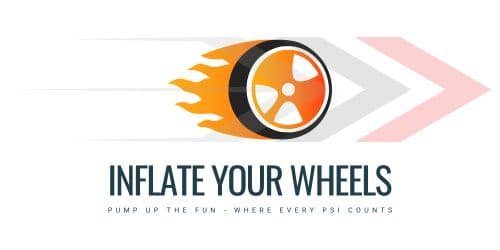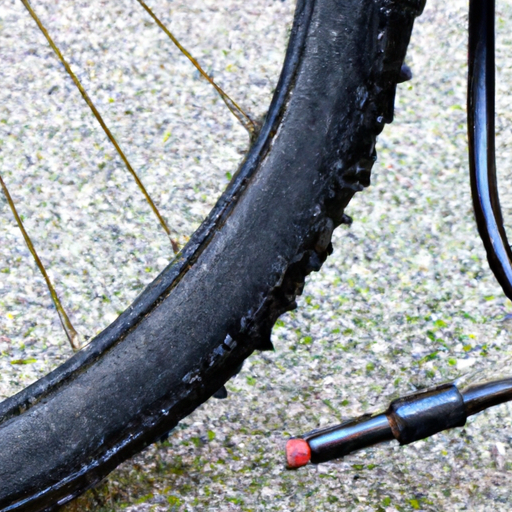You may be surprised to learn that a simple bike pump has the potential to come to your rescue when it comes to inflating a car tire. Despite their apparent differences in size and functionality, bike pumps can actually serve as an effective temporary solution for filling up a deflated car tire.
In this article, we will explore the feasibility of using a bike pump to inflate car tires, examining the practicality, limitations, and considerations involved in this unconventional approach. So, if you’ve ever found yourself in a bind with a flat tire and a bike pump on hand, read on to discover if it’s worth giving it a try.

Table of Contents
Will A Bike Pump Inflate A Car Tire
Introduction
If you find yourself with a flat car tire and no access to an air compressor or a repair shop, you might be wondering if a bike pump can come to the rescue. Bike pumps are commonly used to inflate bicycle tires, but can they handle the larger size and higher pressure of a car tire?
In this article, we will explore whether a bike pump is suitable for inflating car tires, the different types of bike pumps available, the types of car tires you might encounter, factors to consider when using a bike pump for car tires, the maximum PSI (pounds per square inch) of bike pumps, the maximum PSI required for car tires, the inflation time, potential risks and damages, and alternative options available.
Types of Bike Pumps
Before we dive into the question of whether a bike pump can inflate a car tire, let’s explore the different types of bike pumps available. Knowing the different types will help us understand their capabilities and limitations. The four main types of bike pumps are:
- Floor Pump: Also known as a track pump, a floor pump is the largest and most efficient type of bike pump. It typically has a built-in pressure gauge and a long hose, allowing for easy inflation of both high-volume and high-pressure tires.
- Hand Pump: A hand pump is a portable and compact pump that is suitable for inflating bike tires on the go. While it can be used to inflate car tires in an emergency, it might require more effort and time due to its smaller size and lower volume capacity.
- Mini Pump: Similar to a hand pump, a mini pump is designed for easy portability. It is smaller and lighter than a hand pump, but also has a lower volume capacity. While it can be a handy tool for inflating bike tires, using it to inflate a car tire may be more time-consuming and physically demanding.
- CO2 Inflators: CO2 inflators use compressed carbon dioxide cartridges to quickly and easily inflate bike tires. They are lightweight and compact, making them convenient for carrying during bike rides. However, they are not suitable for inflating car tires due to the limited volume of CO2 cartridges.
Types of Car Tires
Just as there are different types of bike pumps, there are also various types of car tires. The type of car tire you have can affect whether a bike pump is capable of inflating it. Some common types of car tires include:
- Standard Tubeless Tires: These tires do not have an inner tube and rely on airtight seals to maintain pressure. They are commonly found on modern cars and are compatible with both Presta and Schrader valves.
- Run-Flat Tires: Run-flat tires are designed to be driven on even after a puncture or loss of pressure. They have reinforced sidewalls that can support the weight of the vehicle for a limited distance at reduced speeds. Inflating run-flat tires with a bike pump may not be effective due to their specialized design and higher pressure requirements.
- Puncture-Proof Tires: Puncture-proof tires, also known as solid or airless tires, are made from resilient materials that cannot be punctured. They are commonly used in industrial and commercial applications. Since these tires are not designed to hold air, attempting to inflate them with a bike pump would be futile.
- Tires with TPMS Sensors: Some modern cars are equipped with a Tire Pressure Monitoring System (TPMS), which constantly monitors the air pressure in the tires. These sensors are attached to the valve stems and can be damaged if not handled properly. When using a bike pump on car tires with TPMS sensors, extra care must be taken to avoid damaging the sensors.
Comparison of Bike Pump and Car Tire Valve
Now that we are familiar with the different types of bike pumps and car tires, let’s explore the compatibility between bike pumps and car tire valves. Bike pumps typically come with either a Presta valve or a Schrader valve, sometimes with the option for both. Car tires generally use Schrader valves, which are larger and more robust than Presta valves.
However, with the help of valve adapters, it is possible to use a bike pump with both Presta and Schrader valves. These adapters allow you to convert the bike pump’s valve head to match the valve type of the car tire, ensuring a secure connection for inflation.
Factors to Consider
Before inflating a car tire with a bike pump, there are several factors to consider. These factors will determine whether a bike pump is suitable for your specific situation. Consider the following:
- Tire Volume: Bike pumps vary in their volume capacity, and car tires typically require a greater volume of air compared to bicycle tires. Ensure that the bike pump you choose can deliver an adequate amount of air to properly inflate your car tire.
- Tire Pressure Requirements: Different car tires have different recommended tire pressure ranges. Make sure that the bike pump you have can reach the required pressure for your car tire to ensure proper inflation and optimal tire performance.
- Pipe Diameter and Length: The diameter and length of the pump’s pipe can also affect the efficiency of inflation. A longer and wider pipe allows for a higher volume of air flow, making the inflation process quicker and easier.
- Strength and Durability of Pump: Inflating a car tire requires more force compared to inflating a bicycle tire. Ensure that the bike pump you use is strong and durable enough to handle the increased pressure and repetitive pumping required for car tires.
- Weather Conditions: Extreme weather conditions, such as high heat or freezing temperatures, can affect the performance of bike pumps. Take into account the environmental conditions in which you will be inflating the tire and choose a pump that can withstand those conditions.
Max PSI of Bike Pump
PSI stands for pounds per square inch, and it is the unit used to measure air pressure. Each bike pump has a maximum PSI rating, which indicates the highest pressure it can deliver. It is important to choose a bike pump with an adequate maximum PSI to ensure it can handle the required pressure for inflating car tires. The maximum PSI of bike pumps can vary depending on the type and quality of the pump.
Max PSI Required for Car Tires
Car tires have specific recommended PSI ranges provided by the manufacturer. It is essential to adhere to these guidelines to ensure proper tire performance, safety, and longevity. The maximum PSI required for car tires can vary depending on the tire size, load capacity, and driving conditions. Generally, car tires require higher PSI compared to bicycle tires due to their larger size and heavier loads.
Inflation Time
The inflation time is an important consideration when deciding whether to use a bike pump or explore alternative options. Inflation with a bike pump may take longer compared to using a car air compressor or other specialized inflation tools. The efficiency of a bike pump in inflating a car tire depends on several factors, such as the pump’s volume capacity, the pump’s strength, and the tire’s volume and pressure requirements. Understanding that a bike pump may take more time for inflation can help manage time expectations and plan accordingly.
Efficiency of Bike Pump
While a bike pump can be used to inflate a car tire in an emergency, it is important to note that it may not be as efficient as other dedicated tools. Car air compressors are specifically designed to handle the volume and pressure requirements of car tires, providing quicker inflation times and more reliable results. If time and efficiency are crucial, using a car air compressor or other specialized inflation tools may be a more fitting option.
Potential Risks and Damages
Inflating a car tire with a bike pump carries potential risks and damages that should be taken into consideration. The increased force and pressure required for car tires can put excessive strain on the bike pump and its components, potentially leading to damage or failure. Additionally, if the bike pump does not deliver enough air or is not capable of reaching the required pressure, underinflation can occur, negatively impacting tire performance and safety. It is vital to be aware of these potential risks and employ caution when using a bike pump for car tires.
Alternatives to Bike Pump for Car Tires
While a bike pump can be a handy tool in an emergency, there are alternative options available for inflating car tires:
- Using Car Air Compressor: Car air compressors are designed specifically for inflating car tires. They offer quicker inflation times, higher volume and pressure capacities, and often come with built-in pressure gauges for accurate inflation.
- Visiting Gas Stations or Service Centers: Many gas stations and service centers have air compressors available for public use. These compressors are designed for car tires and can provide a convenient and reliable option for inflation.
- Portable Electric Inflators: Portable electric inflators are compact and easy to use. They can be powered by your car’s cigarette lighter or a separate battery pack. These inflators vary in their volume and pressure capabilities, so ensure you choose one suitable for your car tire’s requirements.
- Emergency Tire Repair Kits: Some emergency tire repair kits come equipped with a small air compressor or a can of compressed air. These kits are designed to temporarily repair punctures and inflate the tire until you can reach a repair shop.
In conclusion, while a bike pump can technically be used to inflate a car tire in an emergency, it may not be the most efficient or reliable option. Bike pumps come in various types that have different volume capacities and maximum PSI ratings. Car tires also have specific pressure requirements that must be adhered to for optimal performance and safety.
Considering factors such as tire volume, pressure requirements, pipe diameter, and strength of the pump is essential when deciding whether a bike pump is suitable for your specific situation. It is always recommended to use the appropriate tools designed specifically for car tire inflation, such as car air compressors, to ensure efficient and reliable results.

Keep your car tires in peak condition with the right inflator.
Discovering the best tire inflator can be a game-changer for maintaining your vehicle. Explore our comprehensive Ultimate Guide to the Best Tire Inflators to make an informed decision.

